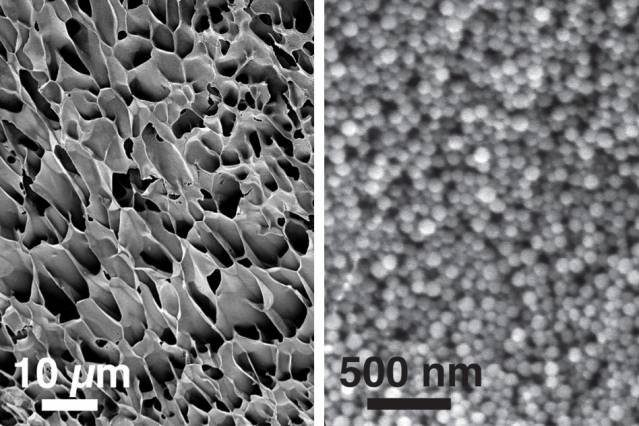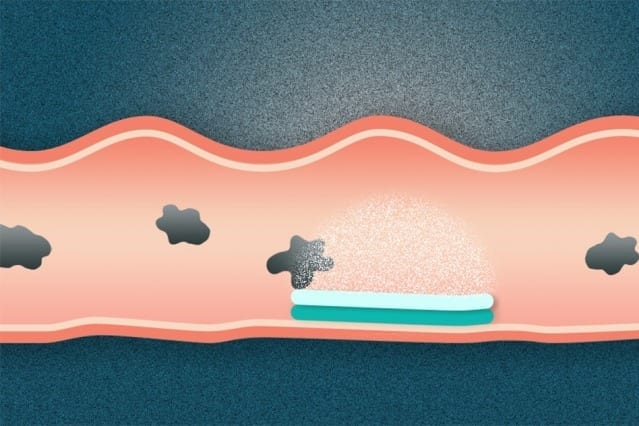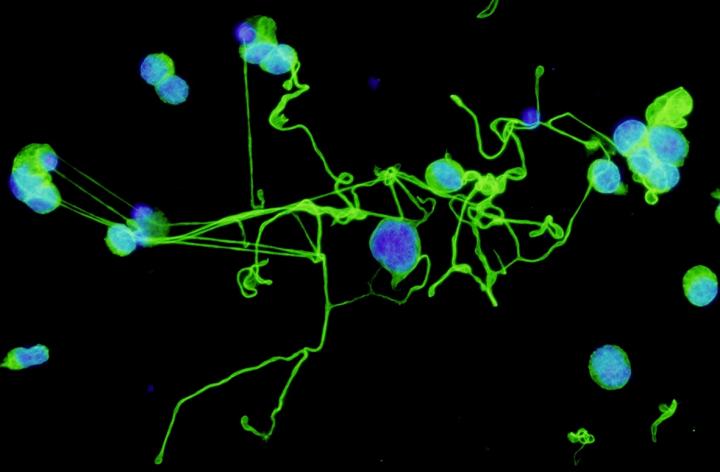
Courtesy of the researchers
Self-healing gel can be injected into the body and act as a long-term drug depot
Scientists are interested in using gels to deliver drugs because they can be molded into specific shapes and designed to release their payload over a specified time period. However, current versions aren’t always practical because must be implanted surgically.
To help overcome that obstacle, MIT chemical engineers have designed a new type of self-healing hydrogel that could be injected through a syringe. Such gels, which can carry one or two drugs at a time, could be useful for treating cancer, macular degeneration, or heart disease, among other diseases, the researchers say.
The new gel consists of a mesh network made of two components: nanoparticles made of polymers entwined within strands of another polymer, such as cellulose.
“Now you have a gel that can change shape when you apply stress to it, and then, importantly, it can re-heal when you relax those forces. That allows you to squeeze it through a syringe or a needle and get it into the body without surgery,” says Mark Tibbitt, a postdoc at MIT’s Koch Institute for Integrative Cancer Research and one of the lead authors of a paper describing the gel in Nature Communications on Feb. 19.
Koch Institute postdoc Eric Appel is also a lead author of the paper, and the paper’s senior author is Robert Langer, the David H. Koch Institute Professor at MIT. Other authors are postdoc Matthew Webber, undergraduate Bradley Mattix, and postdoc Omid Veiseh.
Heal thyself
Scientists have previously constructed hydrogels for biomedical uses by forming irreversible chemical linkages between polymers. These gels, used to make soft contact lenses, among other applications, are tough and sturdy, but once they are formed their shape cannot easily be altered.
The MIT team set out to create a gel that could survive strong mechanical forces, known as shear forces, and then reform itself. Other researchers have created such gels by engineering proteins that self-assemble into hydrogels, but this approach requires complex biochemical processes. The MIT team wanted to design something simpler.
“We’re working with really simple materials,” Tibbitt says. “They don’t require any advanced chemical functionalization.”
The MIT approach relies on a combination of two readily available components. One is a type of nanoparticle formed of PEG-PLA copolymers, first developed in Langer’s lab decades ago and now commonly used to package and deliver drugs. To form a hydrogel, the researchers mixed these particles with a polymer — in this case, cellulose.
Each polymer chain forms weak bonds with many nanoparticles, producing a loosely woven lattice of polymers and nanoparticles. Because each attachment point is fairly weak, the bonds break apart under mechanical stress, such as when injected through a syringe. When the shear forces are over, the polymers and nanoparticles form new attachments with different partners, healing the gel.
Using two components to form the gel also gives the researchers the opportunity to deliver two different drugs at the same time. PEG-PLA nanoparticles have an inner core that is ideally suited to carry hydrophobic small-molecule drugs, which include many chemotherapy drugs. Meanwhile, the polymers, which exist in a watery solution, can carry hydrophilic molecules such as proteins, including antibodies and growth factors.
Long-term drug delivery
In this study, the researchers showed that the gels survived injection under the skin of mice and successfully released two drugs, one hydrophobic and one hydrophilic, over several days.
Read more: New nanogel for drug delivery
The Latest on: Nanogel for drug delivery
[google_news title=”” keyword=”Nanogel for drug delivery” num_posts=”10″ blurb_length=”0″ show_thumb=”left”]
via Google News
The Latest on: Nanogel for drug delivery
- NTU scientists develop revolutionary drug delivery system inspired by caterpillarson May 7, 2024 at 8:47 pm
SINGAPORE: A team of scientists from Nanyang Technological University (NTU) has created a novel drug delivery system that draws inspiration from the natural world. Using the unique self-assembling ...
- Nature's Blueprint: Biodegradable Materials in Engineered Drug Delivery Systemson May 7, 2024 at 1:09 am
In the field of pharmaceutical sciences, drug is delivered either by conventional mode or controlled/ targeted mode to treat the disease. In controlled drug delivery, drug concentration is maintained ...
- Practical Considerations for Optimal Transdermal Drug Deliveryon May 5, 2024 at 5:00 pm
Medication patches are available in a limited number of dosage strengths. Occasionally, some patients require a different dosage of a medication than the dosages commercially available in patch ...
- Nose-to-brain drug delivery by HS15 micelles for brain targeting of insoluble drugon May 4, 2024 at 5:00 pm
Announcing a new publication for Acta Materia Medica journal. Agomelatine (AGO) is an antidepressant with limited clinical application due to its low bioavailability caused by poor water solubility, ...
- A closed-loop drug-delivery system could improve chemotherapyon April 25, 2024 at 3:56 pm
To improve chemotherapy dosing, engineers designed CLAUDIA, a way to continuously measure how much drug is in a patient's system during hours-long infusion. When cancer patients undergo ...
- Formulation and Delivery 2024on April 25, 2024 at 1:00 am
The 2024 event will be opened by the highly acknowledged expert Thomas von Erlach, Chief Scientific Officer at Vivtex highlighting Drug Delivery Systems For Biologics. This is the event to attend to ...
- News tagged with drug delivery systemon April 24, 2024 at 5:00 pm
The delivery of such life-saving therapeutic drugs has evolved with the rise of nanotechnology-based drug ... Injecting drugs into the bloodstream can often harm healthy tissues as well.
- European XFEL elicits secrets from an important nanogelon April 19, 2024 at 12:08 pm
As a consequence, nanogel particles ... such as the development of more efficient drug delivery systems.
- European XFEL elicits secrets from an important nanogelon April 18, 2024 at 5:00 pm
As a consequence, nanogel particles ... such as the development of more efficient drug delivery systems. More information: Francesco Dallari et al, Real-time swelling-collapse kinetics of nanogels ...
- X-ray laser study elicits secrets from an important nanogelon April 18, 2024 at 5:00 pm
As consequence, nanogel particles, as investigated by Lehmkühler and ... such as the development of more efficient drug delivery systems.
via Bing News










